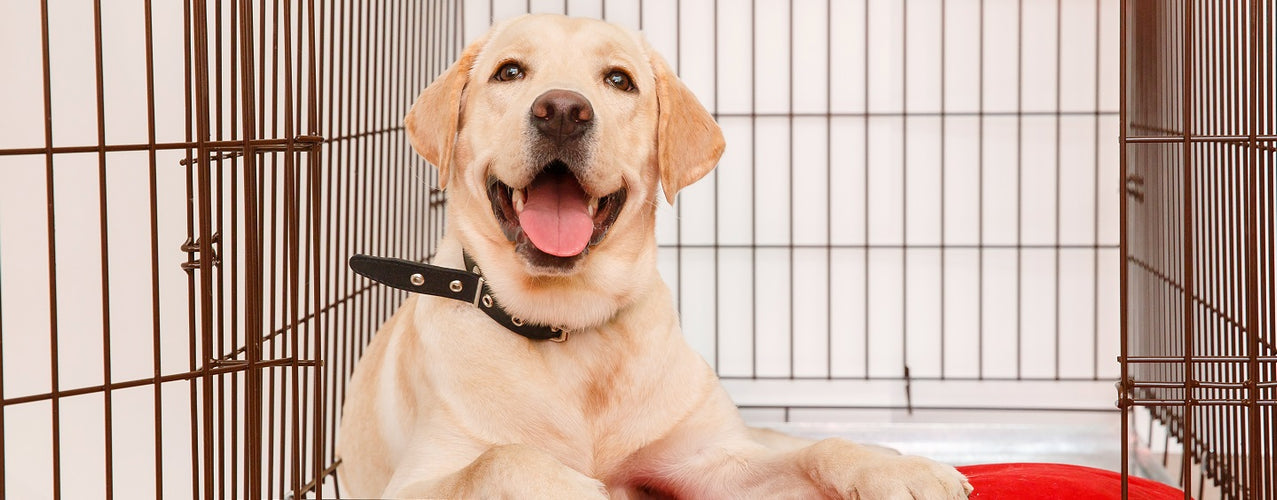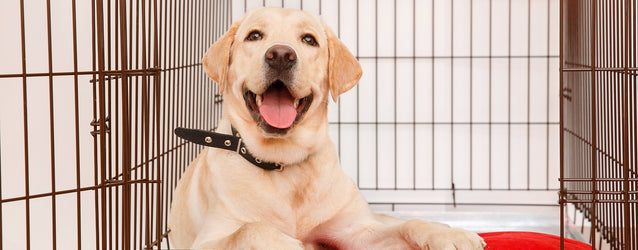

Posted by Emma Oldroyd, on
Dog Crate Setup: Your Dog Crate Questions Answered
Whether or not to use a dog crate can be one of the biggest decision you make when welcoming a new dog or puppy into the family. Pet parents have many questions about crates, so we’ve put together a quick list of our most frequently asked crate questions with answers from our experts!
What is a dog crate?
A dog crate, or indoor kennel, is a specific space your dog can use as their own and feel safe and secure. They’re widely available, and, as well as effectively being a dog’s ‘own room’, they can be used to help train puppies and dogs who may need to be left alone for periods of time.
Crates are mainly a wire frame material with a removable base tray, which you can fill with their bedding and toys, so it becomes their own personal space.
How do I use a crate?
First and foremost, investing in a crate essentially means your dog has their own room in the house which is theirs alone.
Crates can also be a great training aid, particularly for toilet training puppies!
Even if your dog hasn’t previously used a crate, in some cases, they can be useful in medical recovery, particularly surgery.
Crates are also perfect for travelling! Whether it’s a staycation or a day trip, securing your dog in a crate within the car will keep them safe and comfortable on any journey. (Article 57 of the highway code requires pets to be fully restrained when travelling in a vehicle)
Crates should never be used as a form of punishment for unwanted behaviours.
How do I choose the right crate for my dog?
The right crate all depends on the size of your dog. As a minimum, your dog’s crate needs to be big enough for them to sit and stand at their full height in, as well as stretch out, lie down in a natural position, and turn around comfortably.
Whilst it can be tempting to invest in a crate that will be big enough for your dog once they become an adult, if their crate is too large, some puppies can be overwhelmed by a vast space. It’s also important that your puppy doesn’t travel in an adult-sized crate as they won’t be secure enough on the journey.
What bedding should I use in my dog’s crate?
A mixture of familiar items can help turn your dog’s crate into their safe haven. Starting with bedding. Again, this can depend on the breed and size of your dog vs their crate, dog mattresses are a good choice for crates, as the rectangle shapes can be bought to fit the bottom of their crate.
For dogs who love to snuggle, a smaller soft-sided bed can help them feel comfortable. If their bed doesn’t fit to the edges of their crate, you can add extra blankets and soft toys to cover the bottom of the crate. Blankets are also a great option for covering some areas of their crate if they are anxious at night or during periods of stress such as firework season. (Remember to always leave at least one side open for ventilation)
Bedding choices can also change with the seasons, for example, during the warmer months your dog may appreciate the cooling feel of the bottom of the crate, and removing any blankets during the Summer will help the airflow through the crate and avoid potentially overheating.
It’s also important to fill their crate with familiar items such as chew toys and treats for them to enjoy. Chew toys and occupier chews are also great if you’re leaving your dog in their crate for a longer period of time.

Should I leave food and water inside my dog’s crate?
Your dog should always have a supply of fresh water, however when it come to puppies and larger dogs, leaving a bowl in their crate could lead to accidents whilst they get used to their space.
If you leave their crate door open, a clip-on bowl for the side of their crate is a good alternative, or, placing their food and water bowls close to their crate lets them know food is nearby, without encroaching into their personal space.
Having food and water nearby to their crate also discourages dogs from going to the toilet within their crate, as they won’t go to the toilet where they eat.
If you need to leave food and water in your dog’s crate as you are leaving them for a longer period of time, or you are using food and water as part of their crate training, always leave the food at the back of the crate to draw your dog inside.
How long should my dog stay in their crate?
Firstly, the timings depend on how you are using the crate. For example, if you are travelling in the car, your dog should always be in the travel crate as the car is moving. On longer journeys with dogs you should always stop for comfort and toilet breaks.
At home, your dog’s crate can be treated like their own bedroom. As long as the door is kept open for them to roam freely, your dog may choose to sleep in there during the day as well as at night, so your dog chooses how long they would like to spend in there.
If you need to leave your adult dog in their crate with the door closed, we would not recommend leaving them for longer than 4 hours. For puppies, no longer than 1 hour, as they have smaller bladders, and this could lead to accidents and anxiety.
Remember, how you and your dog adapt to crate life depends mostly upon your lifestyle. If you have specific questions about crates and crate training, our experts are always on hand either in-store or via social media to help you make the best decision for your dog.
